Nursing Case Study
VerifiedAdded on 2023/04/19
|7
|1848
|133
AI Summary
This nursing case study discusses the case of Eleanor Brown, a 48-year-old woman suffering from severe ulcerative colitis. The study explores the symptoms, pathophysiology, and management of the disease. It also covers topics like visceral pain, blood pressure, and intravenous drug delivery. Find more study material on Desklib.
Contribute Materials
Your contribution can guide someone’s learning journey. Share your
documents today.

Running head: NURSING CASE STUDY
Nursing Case Study
Name of the Student
Name of the University
Author Note
Nursing Case Study
Name of the Student
Name of the University
Author Note
Secure Best Marks with AI Grader
Need help grading? Try our AI Grader for instant feedback on your assignments.
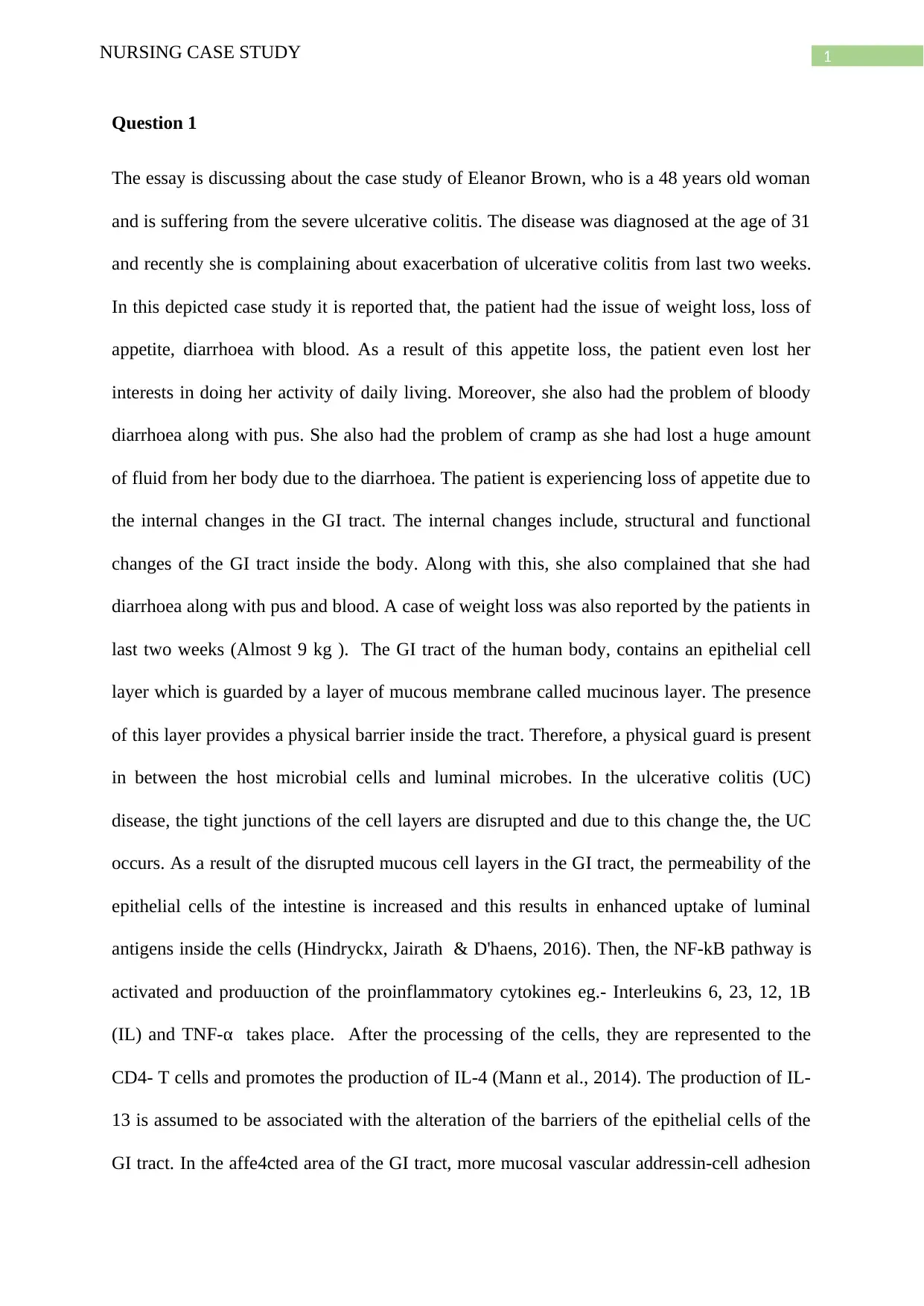
1NURSING CASE STUDY
Question 1
The essay is discussing about the case study of Eleanor Brown, who is a 48 years old woman
and is suffering from the severe ulcerative colitis. The disease was diagnosed at the age of 31
and recently she is complaining about exacerbation of ulcerative colitis from last two weeks.
In this depicted case study it is reported that, the patient had the issue of weight loss, loss of
appetite, diarrhoea with blood. As a result of this appetite loss, the patient even lost her
interests in doing her activity of daily living. Moreover, she also had the problem of bloody
diarrhoea along with pus. She also had the problem of cramp as she had lost a huge amount
of fluid from her body due to the diarrhoea. The patient is experiencing loss of appetite due to
the internal changes in the GI tract. The internal changes include, structural and functional
changes of the GI tract inside the body. Along with this, she also complained that she had
diarrhoea along with pus and blood. A case of weight loss was also reported by the patients in
last two weeks (Almost 9 kg ). The GI tract of the human body, contains an epithelial cell
layer which is guarded by a layer of mucous membrane called mucinous layer. The presence
of this layer provides a physical barrier inside the tract. Therefore, a physical guard is present
in between the host microbial cells and luminal microbes. In the ulcerative colitis (UC)
disease, the tight junctions of the cell layers are disrupted and due to this change the, the UC
occurs. As a result of the disrupted mucous cell layers in the GI tract, the permeability of the
epithelial cells of the intestine is increased and this results in enhanced uptake of luminal
antigens inside the cells (Hindryckx, Jairath & D'haens, 2016). Then, the NF-kB pathway is
activated and produuction of the proinflammatory cytokines eg.- Interleukins 6, 23, 12, 1B
(IL) and TNF-α takes place. After the processing of the cells, they are represented to the
CD4- T cells and promotes the production of IL-4 (Mann et al., 2014). The production of IL-
13 is assumed to be associated with the alteration of the barriers of the epithelial cells of the
GI tract. In the affe4cted area of the GI tract, more mucosal vascular addressin-cell adhesion
Question 1
The essay is discussing about the case study of Eleanor Brown, who is a 48 years old woman
and is suffering from the severe ulcerative colitis. The disease was diagnosed at the age of 31
and recently she is complaining about exacerbation of ulcerative colitis from last two weeks.
In this depicted case study it is reported that, the patient had the issue of weight loss, loss of
appetite, diarrhoea with blood. As a result of this appetite loss, the patient even lost her
interests in doing her activity of daily living. Moreover, she also had the problem of bloody
diarrhoea along with pus. She also had the problem of cramp as she had lost a huge amount
of fluid from her body due to the diarrhoea. The patient is experiencing loss of appetite due to
the internal changes in the GI tract. The internal changes include, structural and functional
changes of the GI tract inside the body. Along with this, she also complained that she had
diarrhoea along with pus and blood. A case of weight loss was also reported by the patients in
last two weeks (Almost 9 kg ). The GI tract of the human body, contains an epithelial cell
layer which is guarded by a layer of mucous membrane called mucinous layer. The presence
of this layer provides a physical barrier inside the tract. Therefore, a physical guard is present
in between the host microbial cells and luminal microbes. In the ulcerative colitis (UC)
disease, the tight junctions of the cell layers are disrupted and due to this change the, the UC
occurs. As a result of the disrupted mucous cell layers in the GI tract, the permeability of the
epithelial cells of the intestine is increased and this results in enhanced uptake of luminal
antigens inside the cells (Hindryckx, Jairath & D'haens, 2016). Then, the NF-kB pathway is
activated and produuction of the proinflammatory cytokines eg.- Interleukins 6, 23, 12, 1B
(IL) and TNF-α takes place. After the processing of the cells, they are represented to the
CD4- T cells and promotes the production of IL-4 (Mann et al., 2014). The production of IL-
13 is assumed to be associated with the alteration of the barriers of the epithelial cells of the
GI tract. In the affe4cted area of the GI tract, more mucosal vascular addressin-cell adhesion
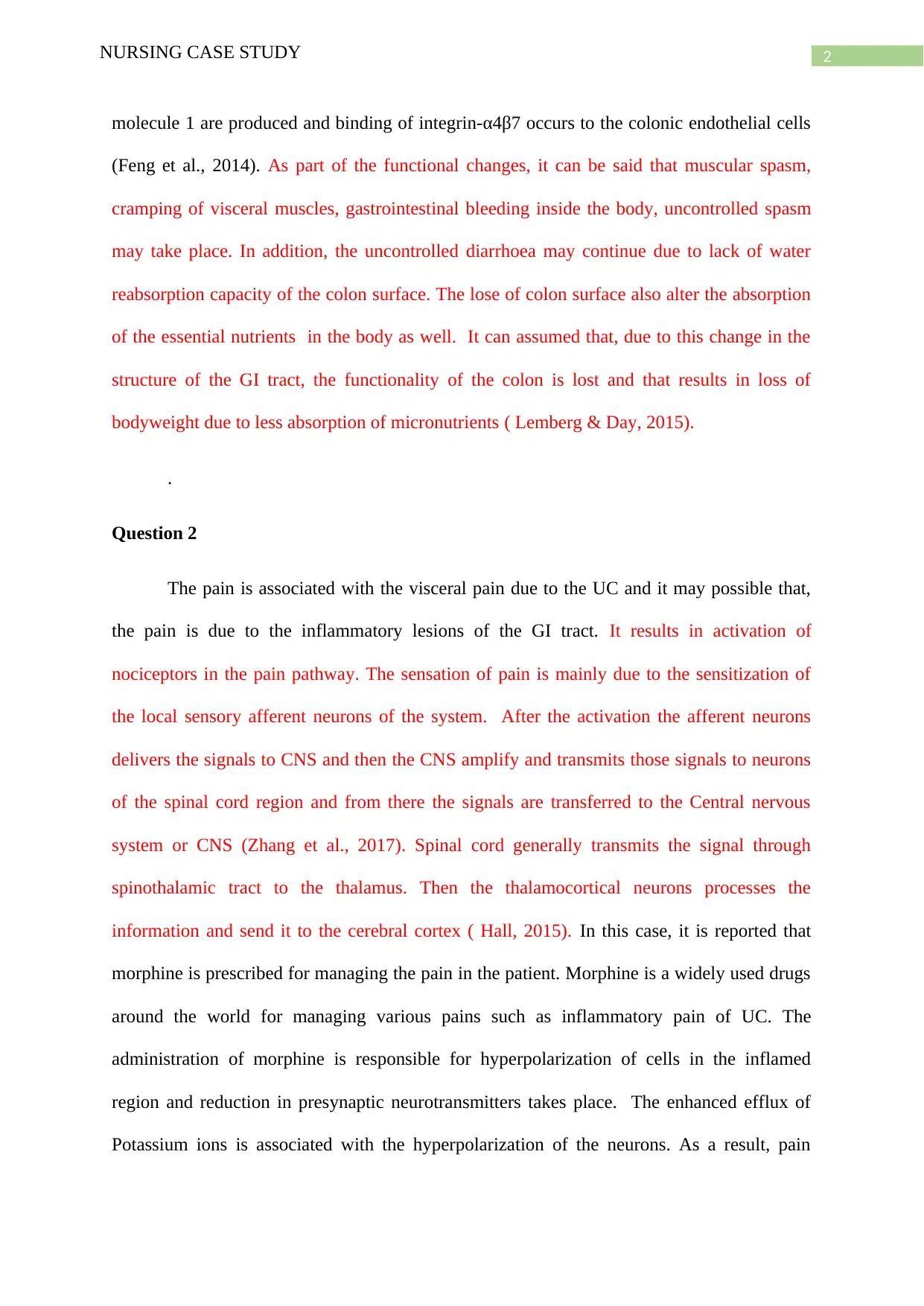
2NURSING CASE STUDY
molecule 1 are produced and binding of integrin-α4β7 occurs to the colonic endothelial cells
(Feng et al., 2014). As part of the functional changes, it can be said that muscular spasm,
cramping of visceral muscles, gastrointestinal bleeding inside the body, uncontrolled spasm
may take place. In addition, the uncontrolled diarrhoea may continue due to lack of water
reabsorption capacity of the colon surface. The lose of colon surface also alter the absorption
of the essential nutrients in the body as well. It can assumed that, due to this change in the
structure of the GI tract, the functionality of the colon is lost and that results in loss of
bodyweight due to less absorption of micronutrients ( Lemberg & Day, 2015).
.
Question 2
The pain is associated with the visceral pain due to the UC and it may possible that,
the pain is due to the inflammatory lesions of the GI tract. It results in activation of
nociceptors in the pain pathway. The sensation of pain is mainly due to the sensitization of
the local sensory afferent neurons of the system. After the activation the afferent neurons
delivers the signals to CNS and then the CNS amplify and transmits those signals to neurons
of the spinal cord region and from there the signals are transferred to the Central nervous
system or CNS (Zhang et al., 2017). Spinal cord generally transmits the signal through
spinothalamic tract to the thalamus. Then the thalamocortical neurons processes the
information and send it to the cerebral cortex ( Hall, 2015). In this case, it is reported that
morphine is prescribed for managing the pain in the patient. Morphine is a widely used drugs
around the world for managing various pains such as inflammatory pain of UC. The
administration of morphine is responsible for hyperpolarization of cells in the inflamed
region and reduction in presynaptic neurotransmitters takes place. The enhanced efflux of
Potassium ions is associated with the hyperpolarization of the neurons. As a result, pain
molecule 1 are produced and binding of integrin-α4β7 occurs to the colonic endothelial cells
(Feng et al., 2014). As part of the functional changes, it can be said that muscular spasm,
cramping of visceral muscles, gastrointestinal bleeding inside the body, uncontrolled spasm
may take place. In addition, the uncontrolled diarrhoea may continue due to lack of water
reabsorption capacity of the colon surface. The lose of colon surface also alter the absorption
of the essential nutrients in the body as well. It can assumed that, due to this change in the
structure of the GI tract, the functionality of the colon is lost and that results in loss of
bodyweight due to less absorption of micronutrients ( Lemberg & Day, 2015).
.
Question 2
The pain is associated with the visceral pain due to the UC and it may possible that,
the pain is due to the inflammatory lesions of the GI tract. It results in activation of
nociceptors in the pain pathway. The sensation of pain is mainly due to the sensitization of
the local sensory afferent neurons of the system. After the activation the afferent neurons
delivers the signals to CNS and then the CNS amplify and transmits those signals to neurons
of the spinal cord region and from there the signals are transferred to the Central nervous
system or CNS (Zhang et al., 2017). Spinal cord generally transmits the signal through
spinothalamic tract to the thalamus. Then the thalamocortical neurons processes the
information and send it to the cerebral cortex ( Hall, 2015). In this case, it is reported that
morphine is prescribed for managing the pain in the patient. Morphine is a widely used drugs
around the world for managing various pains such as inflammatory pain of UC. The
administration of morphine is responsible for hyperpolarization of cells in the inflamed
region and reduction in presynaptic neurotransmitters takes place. The enhanced efflux of
Potassium ions is associated with the hyperpolarization of the neurons. As a result, pain
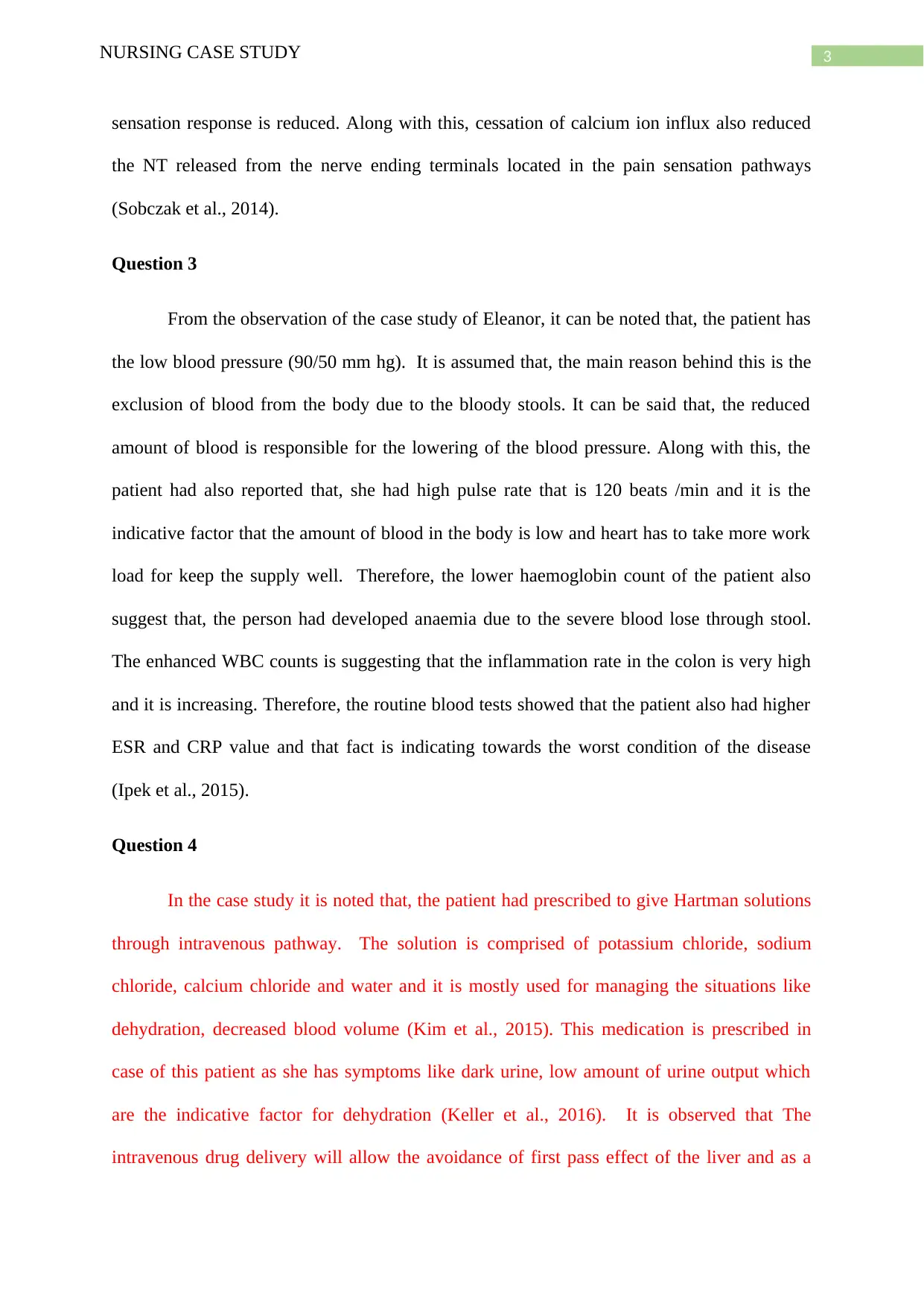
3NURSING CASE STUDY
sensation response is reduced. Along with this, cessation of calcium ion influx also reduced
the NT released from the nerve ending terminals located in the pain sensation pathways
(Sobczak et al., 2014).
Question 3
From the observation of the case study of Eleanor, it can be noted that, the patient has
the low blood pressure (90/50 mm hg). It is assumed that, the main reason behind this is the
exclusion of blood from the body due to the bloody stools. It can be said that, the reduced
amount of blood is responsible for the lowering of the blood pressure. Along with this, the
patient had also reported that, she had high pulse rate that is 120 beats /min and it is the
indicative factor that the amount of blood in the body is low and heart has to take more work
load for keep the supply well. Therefore, the lower haemoglobin count of the patient also
suggest that, the person had developed anaemia due to the severe blood lose through stool.
The enhanced WBC counts is suggesting that the inflammation rate in the colon is very high
and it is increasing. Therefore, the routine blood tests showed that the patient also had higher
ESR and CRP value and that fact is indicating towards the worst condition of the disease
(Ipek et al., 2015).
Question 4
In the case study it is noted that, the patient had prescribed to give Hartman solutions
through intravenous pathway. The solution is comprised of potassium chloride, sodium
chloride, calcium chloride and water and it is mostly used for managing the situations like
dehydration, decreased blood volume (Kim et al., 2015). This medication is prescribed in
case of this patient as she has symptoms like dark urine, low amount of urine output which
are the indicative factor for dehydration (Keller et al., 2016). It is observed that The
intravenous drug delivery will allow the avoidance of first pass effect of the liver and as a
sensation response is reduced. Along with this, cessation of calcium ion influx also reduced
the NT released from the nerve ending terminals located in the pain sensation pathways
(Sobczak et al., 2014).
Question 3
From the observation of the case study of Eleanor, it can be noted that, the patient has
the low blood pressure (90/50 mm hg). It is assumed that, the main reason behind this is the
exclusion of blood from the body due to the bloody stools. It can be said that, the reduced
amount of blood is responsible for the lowering of the blood pressure. Along with this, the
patient had also reported that, she had high pulse rate that is 120 beats /min and it is the
indicative factor that the amount of blood in the body is low and heart has to take more work
load for keep the supply well. Therefore, the lower haemoglobin count of the patient also
suggest that, the person had developed anaemia due to the severe blood lose through stool.
The enhanced WBC counts is suggesting that the inflammation rate in the colon is very high
and it is increasing. Therefore, the routine blood tests showed that the patient also had higher
ESR and CRP value and that fact is indicating towards the worst condition of the disease
(Ipek et al., 2015).
Question 4
In the case study it is noted that, the patient had prescribed to give Hartman solutions
through intravenous pathway. The solution is comprised of potassium chloride, sodium
chloride, calcium chloride and water and it is mostly used for managing the situations like
dehydration, decreased blood volume (Kim et al., 2015). This medication is prescribed in
case of this patient as she has symptoms like dark urine, low amount of urine output which
are the indicative factor for dehydration (Keller et al., 2016). It is observed that The
intravenous drug delivery will allow the avoidance of first pass effect of the liver and as a
Secure Best Marks with AI Grader
Need help grading? Try our AI Grader for instant feedback on your assignments.
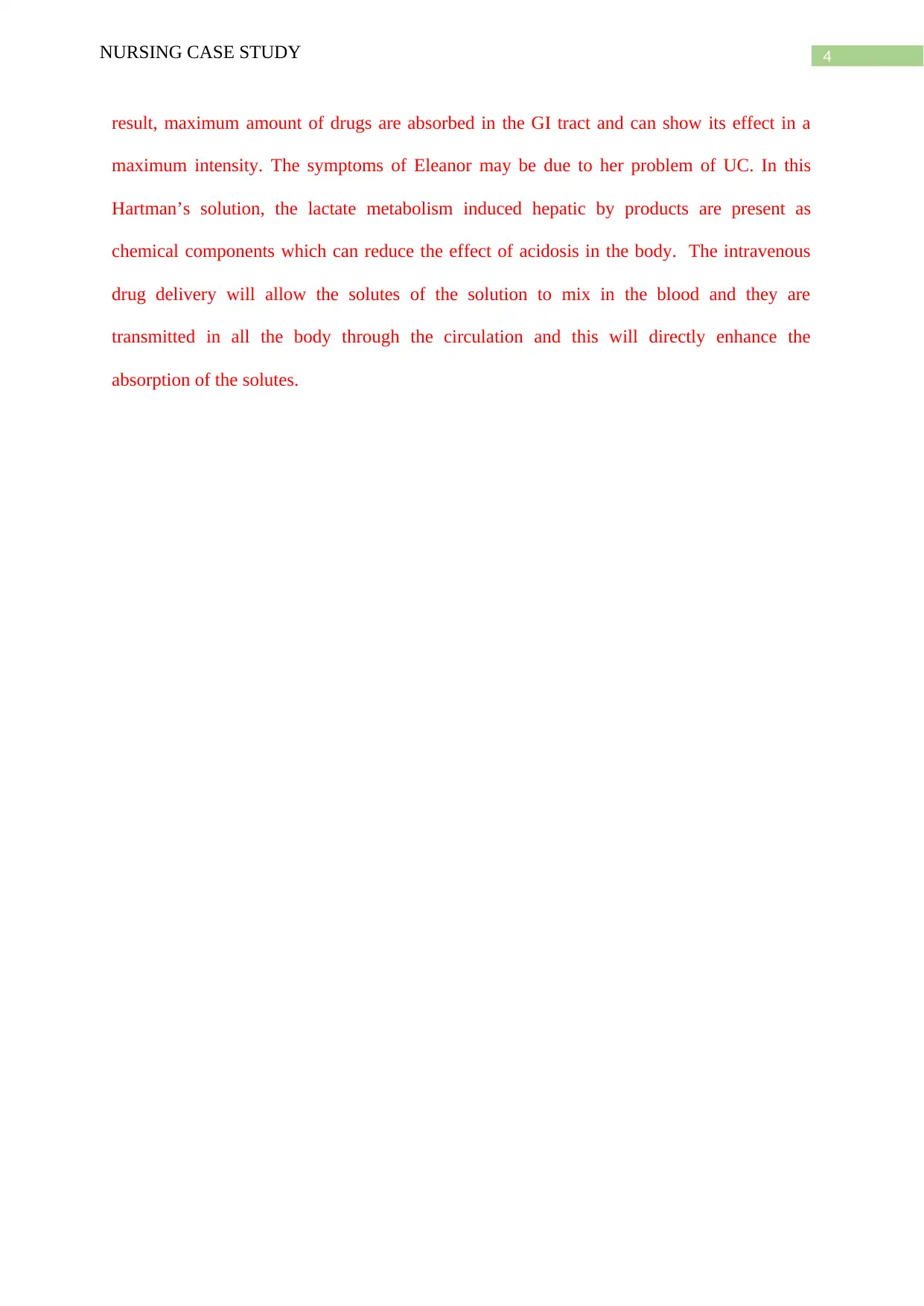
4NURSING CASE STUDY
result, maximum amount of drugs are absorbed in the GI tract and can show its effect in a
maximum intensity. The symptoms of Eleanor may be due to her problem of UC. In this
Hartman’s solution, the lactate metabolism induced hepatic by products are present as
chemical components which can reduce the effect of acidosis in the body. The intravenous
drug delivery will allow the solutes of the solution to mix in the blood and they are
transmitted in all the body through the circulation and this will directly enhance the
absorption of the solutes.
result, maximum amount of drugs are absorbed in the GI tract and can show its effect in a
maximum intensity. The symptoms of Eleanor may be due to her problem of UC. In this
Hartman’s solution, the lactate metabolism induced hepatic by products are present as
chemical components which can reduce the effect of acidosis in the body. The intravenous
drug delivery will allow the solutes of the solution to mix in the blood and they are
transmitted in all the body through the circulation and this will directly enhance the
absorption of the solutes.

5NURSING CASE STUDY
References
Feng, J. S., Yang, Z., Zhu, Y. Z., Liu, Z., Guo, C. C., & Zheng, X. B. (2014). Serum IL-17
and IL-6 increased accompany with TGF-β and IL-13 respectively in ulcerative colitis
patients. International journal of clinical and experimental medicine, 7(12), 5498.
Hindryckx, P., Jairath, V., & D'haens, G. (2016). Acute severe ulcerative colitis: from
pathophysiology to clinical management. Nature Reviews Gastroenterology &
Hepatology, 13(11), 654.
Ipek, S., Cekic, C., Alper, E., Coban, E., Eliacik, E., Arabul, M., ... & Unsal, B. (2015). Can
red cell distribution width be a marker of disease activity in ulcerative
colitis?. International journal of clinical and experimental medicine, 8(8), 13848.
Mann, E. R., Bernardo, D., Ng, S. C., Rigby, R. J., Al-Hassi, H. O., Landy, J., ... & Stagg, A.
J. (2014). Human gut dendritic cells drive aberrant gut-specific t-cell responses in
ulcerative colitis, characterized by increased IL-4 production and loss of IL-22 and
IFNγ. Inflammatory bowel diseases, 20(12), 2299-2307.
Sobczak, M., Pilarczyk, A., Jonakowski, M., Jarmuż, A., Sałaga, M., Lipkowski, A. W., &
Fichna, J. (2014). Anti-inflammatory and antinociceptive action of the dimeric enkephalin
peptide biphalin in the mouse model of colitis: new potential treatment of abdominal pain
associated with inflammatory bowel diseases. Peptides, 60, 102-106.
Zhang, F., Wu, L., Zhao, J., Lv, T., Hu, Z., Weng, Z., ... & Liu, H. (2017). Neurobiological
mechanism of acupuncture for relieving visceral pain of gastrointestinal
origin. Gastroenterology research and practice, 2017.
References
Feng, J. S., Yang, Z., Zhu, Y. Z., Liu, Z., Guo, C. C., & Zheng, X. B. (2014). Serum IL-17
and IL-6 increased accompany with TGF-β and IL-13 respectively in ulcerative colitis
patients. International journal of clinical and experimental medicine, 7(12), 5498.
Hindryckx, P., Jairath, V., & D'haens, G. (2016). Acute severe ulcerative colitis: from
pathophysiology to clinical management. Nature Reviews Gastroenterology &
Hepatology, 13(11), 654.
Ipek, S., Cekic, C., Alper, E., Coban, E., Eliacik, E., Arabul, M., ... & Unsal, B. (2015). Can
red cell distribution width be a marker of disease activity in ulcerative
colitis?. International journal of clinical and experimental medicine, 8(8), 13848.
Mann, E. R., Bernardo, D., Ng, S. C., Rigby, R. J., Al-Hassi, H. O., Landy, J., ... & Stagg, A.
J. (2014). Human gut dendritic cells drive aberrant gut-specific t-cell responses in
ulcerative colitis, characterized by increased IL-4 production and loss of IL-22 and
IFNγ. Inflammatory bowel diseases, 20(12), 2299-2307.
Sobczak, M., Pilarczyk, A., Jonakowski, M., Jarmuż, A., Sałaga, M., Lipkowski, A. W., &
Fichna, J. (2014). Anti-inflammatory and antinociceptive action of the dimeric enkephalin
peptide biphalin in the mouse model of colitis: new potential treatment of abdominal pain
associated with inflammatory bowel diseases. Peptides, 60, 102-106.
Zhang, F., Wu, L., Zhao, J., Lv, T., Hu, Z., Weng, Z., ... & Liu, H. (2017). Neurobiological
mechanism of acupuncture for relieving visceral pain of gastrointestinal
origin. Gastroenterology research and practice, 2017.
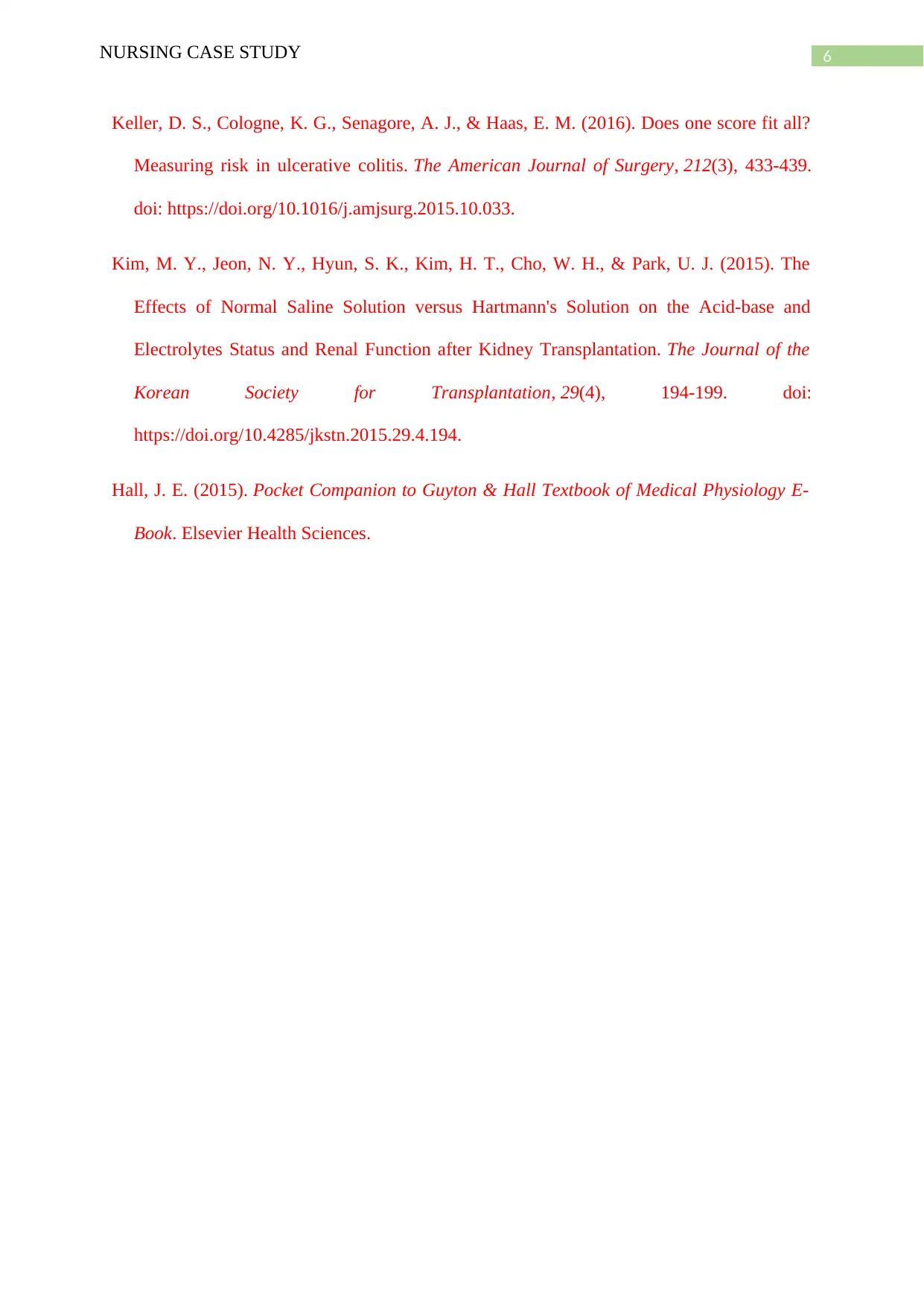
6NURSING CASE STUDY
Keller, D. S., Cologne, K. G., Senagore, A. J., & Haas, E. M. (2016). Does one score fit all?
Measuring risk in ulcerative colitis. The American Journal of Surgery, 212(3), 433-439.
doi: https://doi.org/10.1016/j.amjsurg.2015.10.033.
Kim, M. Y., Jeon, N. Y., Hyun, S. K., Kim, H. T., Cho, W. H., & Park, U. J. (2015). The
Effects of Normal Saline Solution versus Hartmann's Solution on the Acid-base and
Electrolytes Status and Renal Function after Kidney Transplantation. The Journal of the
Korean Society for Transplantation, 29(4), 194-199. doi:
https://doi.org/10.4285/jkstn.2015.29.4.194.
Hall, J. E. (2015). Pocket Companion to Guyton & Hall Textbook of Medical Physiology E-
Book. Elsevier Health Sciences.
Keller, D. S., Cologne, K. G., Senagore, A. J., & Haas, E. M. (2016). Does one score fit all?
Measuring risk in ulcerative colitis. The American Journal of Surgery, 212(3), 433-439.
doi: https://doi.org/10.1016/j.amjsurg.2015.10.033.
Kim, M. Y., Jeon, N. Y., Hyun, S. K., Kim, H. T., Cho, W. H., & Park, U. J. (2015). The
Effects of Normal Saline Solution versus Hartmann's Solution on the Acid-base and
Electrolytes Status and Renal Function after Kidney Transplantation. The Journal of the
Korean Society for Transplantation, 29(4), 194-199. doi:
https://doi.org/10.4285/jkstn.2015.29.4.194.
Hall, J. E. (2015). Pocket Companion to Guyton & Hall Textbook of Medical Physiology E-
Book. Elsevier Health Sciences.
1 out of 7
Related Documents
Your All-in-One AI-Powered Toolkit for Academic Success.
+13062052269
info@desklib.com
Available 24*7 on WhatsApp / Email
![[object Object]](/_next/static/media/star-bottom.7253800d.svg)
Unlock your academic potential
© 2024 | Zucol Services PVT LTD | All rights reserved.





